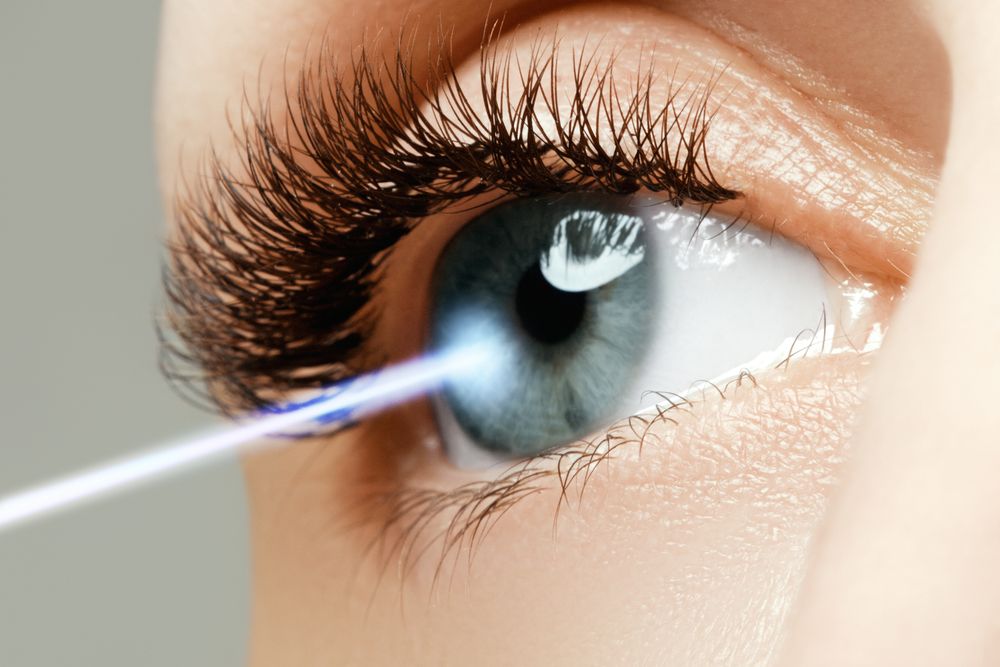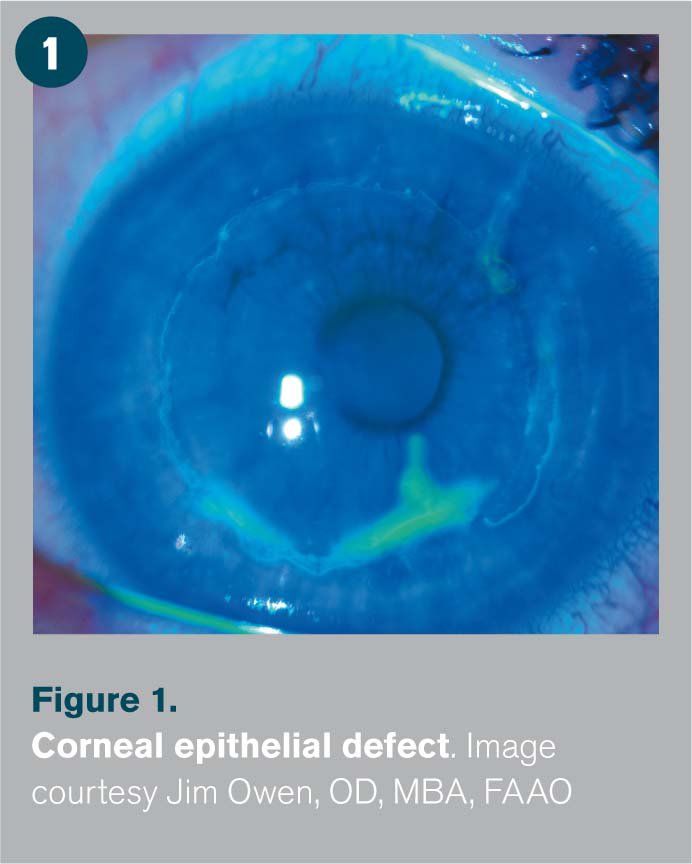Preparing your patient for PRK
Photorefractive keratectomy (PRK) was the original excimer laser procedure approved by the FDA-and is still a safe and effective treatment of refractive errors. PRK has the benefits of no-flap creation; therefore, there is no risk of flap complications.


Photorefractive keratectomy (PRK) was the original excimer laser procedure approved by the FDA-and is still a safe and effective treatment of refractive errors. PRK has the benefits of no-flap creation; therefore, there is no risk of flap complications. In PRK, the treatment of the stromal bed is more shallow as compared to LASIK, resulting in less risk of ectasia.
Short-term postoperative pain and slower visual recovery are disadvantages of this type of refractive surgery. Over the years, variations in pre-operative care, surgical treatment, and postoperative care have been evaluated, including the use of topical morphine to alleviate postoperative pain.1
PRK requires the removal of approximately 8 mm in diameter of corneal epithelium (Figure 1). This large epithelial defect leaves corneal nerves exposed, resulting in significant pain and discomfort for the patient. This defect usually heals within three to five days.
Managing postoperative pain
While I contend that males above 6 feet 3 inches have the worst pain, no published literature supports this repeated observation. It would be great if we could predict which patients would have the most pain after surgery.
Researchers have looked for predictors including age, race, spherical equivalent, and even anxiety scores without any correlation to pain.2
It is important to inform all patients undergoing PRK that they will experience some pain in the immediate postoperative period. It is better for the patient to experience less pain than you describe, not more.
The treatment of PRK pain can start prior to surgery. Studies show starting a non-steroidal anti-inflammatory (NSAID) drops prior to surgery decreases postoperative pain.3 In a randomized masked trial, patients were administered a drop of diclofenac 0.1 percent (Voltaren, Novartis) in one eye and one drop of placebo in the other eye two hours before PRK. Postoperatively, both eyes of each patient received topical diclofenac every six hours for two days.3
There were 140 eyes in this study that showed a statistical difference in pain scores 24 hours after surgery.3 That difference went away 48 hours after surgery. The eyes which received the diclofenac had less pain than those which received the placebo.3
In a study comparing diclofenac 0.1 percent and ketorolac 0.5 percent (Acular, Allergan), Hong et al found both were effective in reducing post-operative pain. He also found no significant difference between the two NSAIDS.4
PRK treatment options
PRK can go by many different names, including advanced surface ablation (ASA), laser epithelial keratomileusis (LASEK), epi-LASIK, and others. These are various means of removing the epithelium in hopes of improved healing time and reduced postoperative pain.
Einollahi et al found events with mechanical removal of epithelium, rather than using alcohol, and no difference in pain. Chayet and Schanzlin found less postoperative pain with PRK than epi-LASIK (epithelium removed with an epitome).5,6 There does not appear to be a difference in postoperative pain based on how the epithelium is removed-but pain is improved when it is completely removed.7
A bandage contact lens has been significant in lowering postoperative pain following PRK.8 The lens is applied immediately after the procedure and should not be removed until the epithelium is healed.
In a 2014 study, patients having PRK were randomly assigned postoperatively to a senofilcon A (Acuvue Oasys, Johnson & Johnson Vision Care), balafilcon A (PureVision, Bausch + Lomb), or lotrafilcon A (Air Optix, Alcon) bandage contact lens in each eye.9 The senofilcon A lens caused the least pain.
In two separate studies, Air Optix Night & Day (Alcon) yielded less postoperative pain when compared to CooperVision Proclear, a phosphorylcholine contact lens,10 and less postoperative pain when compared to Acuvue Oasys in a 2005 study of 100 eyes.11 These studies were conducted by the United States Army and Navy, respectively-who originally performed only PRK on their patients.
Oral analgesics are often prescribed postoperatively for PRK patients with variable success. Ibuprofen and acetaminophen have been used independently and in combination. Time-release oral diclofenac (Voltaren-XR, Novartis) has been shown to be superior in a study of 33 PRK patients.12 Opioids of varying strength and combination are often used during the healing of the corneal epithelium, but their effect on the patient’s mental status and alertness may be as significant as their effect on corneal pain.
Gabapentin has been found in some studies to decrease corneal pain. In a randomized masked placebo-controlled study,13 20 patients received 300 mg of gabapentin (Neurontin, Pfizer) for the first 72 hours postoperatively.
These patients were compared to a matched placebo group, and both groups completed daily pain surveys. The gabapentin group had significantly less pain during the first 48 hours.13 Another study has shown less significant results.14
Future of PRK treatment
Clinicians continue to research techniques to speed the healing of the corneal epithelium, and decrease patient discomfort after PRK surgery. The combination of NSAIDS, bandage contact lenses, and oral pain medications have dramatically reduced the pain patients’ experience after PRK surgery.
Unfortunately, pain is a very individual symptom, and some patients report a significant amount of pain after PRK surgery. It is always necessary to prepare your patient for the worst and hope for the best.
References:
1. Faktorovich EG, Basbaum AI. Effect of topical 0.5% morphine on postoperative pain after photorefractive keratectomy. J Refract Surg. 2010 Dec;26(12):934-41.
2. Abri Aghdam K, Aghaei H, Shokrollahi S, Joshaghani M, Nazari H, Hashemi M, Ghaempanah MJ. Comparison of the effect of cycloplegic versus NSAID eye drops on pain after photorefractive keratectomy. J Curr Ophthalmol. 2016 Jan 8;27(3-4):87-91.
3. Mohammadpour M, Jabbarvand M, Nikdel M, Adelpour M, Karimi N. Effect of preemptive topical diclofenac on postoperative pain relief after photorefractive keratectomy. J Cataract Refract Surg. 2011 Apr;37(4):633-7.
4. Hong JP, Nam SM, Im CY, Yoon S, Kim TI, Kim EK, Seo KY. Comparison of analgesic effect of preoperative topical diclofenac and ketorolac on postoperative pain after photorefractive keratectomy. J Cataract Refract Surg. 2014 Oct;40(10):1689-96.
5. Einollahi B, Baradaran-Rafii A, Rezaei-Kanavi M, Eslani M, Parchegani MR, Zare M, Feizi S, Karimian F. Mechanical versus alcohol-assisted epithelial debridement during photorefractive keratectomy: a confocal microscopic clinical trial. J Refract Surg. 2011 Dec;27(12):887-93.
6. Torres LF, Sancho C, Tan B, Padilla K, Schanzlin DJ, Chayet AS. Early postoperative pain following Epi-LASIK and photorefractive keratectomy: a prospective, comparative, bilateral study. J Refract Surg. 2007 Feb;23(2):126-32.
7. Lee HK, Lee KS, Kim JK, Kim HC, Seo KR, Kim EK. Epithelial healing and clinical outcomes in excimer laser photorefractive surgery following three epithelial removal techniques: mechanical, alcohol, and excimer laser. Am J Ophthalmol. 2005 Jan;139(1):56-63.
8. Taneri S, Oehler S, MacRae S, Dick HB. Influence of a therapeutic soft contact lens on epithelial healing, visual recovery, haze, and pain after photorefractive keratectomy. Eye Contact Lens. 2016 Aug 30. [Epub ahead of print]
9. Taylor KR, Caldwell MC, Payne AM, Apsey DA, Townley JR, Reilly CD, Panday VA. Comparison of 3 silicone hydrogel bandage soft contact lenses for pain control after photorefractive keratectomy. J Cataract Refract Surg. 2014 Nov;40(11):1798-804.
10. Edwards JD1, Bower KS, Sediq DA, Burka JM, Stutzman RD, Vanroekel CR, Kuzmowych CP, Eaddy JB. Effects of lotrafilcon A and omafilcon A bandage contact lenses on visual outcomes after photorefractive keratectomy. J Cataract Refract Surg. 2008 Aug;34(8):1288-94.
11. Engle AT, Laurent JM, Schallhorn SC, Toman SD, Newacheck JS, Tanzer DJ, Tidwell JL. Masked comparison of silicone hydrogel lotrafilcon A and etafilcon A extended-wear bandage contact lenses after photorefractive keratectomy. J Cataract Refract Surg. 2005 Apr;31(4):681-6.
12. Eslampour A, Malaekeh-Nikouei B, Abrishami M, Bayani R. Efficacy of extended-release oral diclofenac in postoperative pain management after photorefractive keratectomy. J Ocul Pharmacol Ther. 2013 Sep;29(7):670-3.
13. Lichtinger A, Purcell TL, Schanzlin DJ, Chayet AS. Gabapentin for postoperative pain after photorefractive keratectomy: a prospective, randomized, double-blind, placebo-controlled trial. J Refract Surg. 2011 Aug;27(8):613-7.
14. Nissman SA, Tractenberg RE, Babbar-Goel A, Pasternak JF. Oral gabapentin for the treatment of postoperative pain after photorefractive keratectomy. Am J Ophthalmol. 2008 Apr;145(4):623-629.
Newsletter
Want more insights like this? Subscribe to Optometry Times and get clinical pearls and practice tips delivered straight to your inbox.